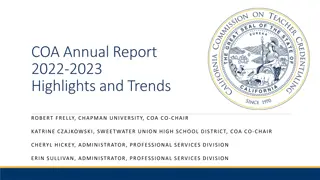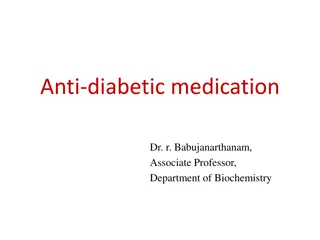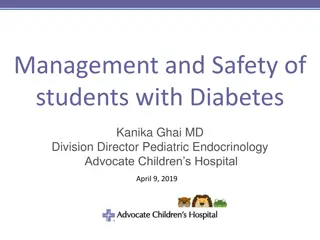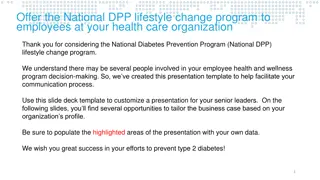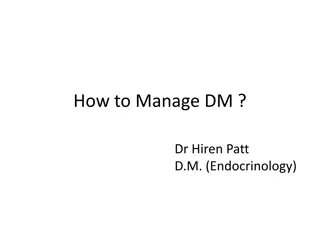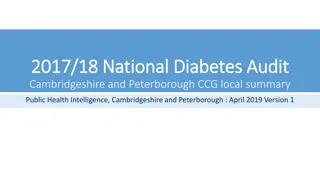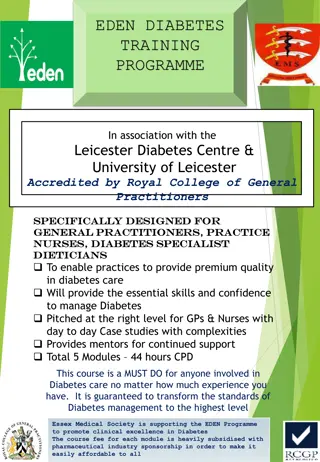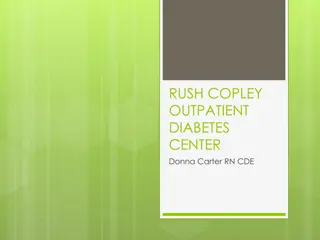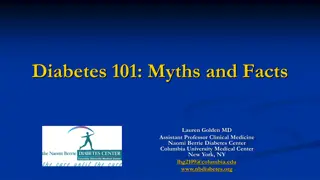Theresa S. Clark - Diabetes Educator Program Coordinator
Theresa S. Clark, MS, RD, LD, CDE, BC-ADM, is a dedicated Diabetes Educator and Program Coordinator at the Diabetes Resource Center in Hopkinsville, KY. She specializes in insulin therapies and teaches patients about insulin administration, carbohydrate counting, and mealtime insulin dosing. Certified in pump training for major corporations, Theresa ensures learners understand basal versus mealtime insulin, insulin sensitivity factors, and more. Her expertise allows accredited programs to bill for DSME and MNT services related to insulin education.
Download Presentation

Please find below an Image/Link to download the presentation.
The content on the website is provided AS IS for your information and personal use only. It may not be sold, licensed, or shared on other websites without obtaining consent from the author.If you encounter any issues during the download, it is possible that the publisher has removed the file from their server.
You are allowed to download the files provided on this website for personal or commercial use, subject to the condition that they are used lawfully. All files are the property of their respective owners.
The content on the website is provided AS IS for your information and personal use only. It may not be sold, licensed, or shared on other websites without obtaining consent from the author.
E N D
Presentation Transcript
Theresa S. Clark MS, RD, LD, CDE, BC-ADM Diabetes Educator Program Coordinator Diabetes Resource Center Hopkinsville, KY.
Disclosure to Participants Notice of Requirements For Successful Completion Please refer to learning goals and objectives Learners must attend the full activity and complete the evaluation in order to claim continuing education credit/hours Conflict of Interest (COI) and Financial Relationship Disclosures: Field Trainer for DexCom Corporation Certified Pump Trainer for Medtronic Corporation Certified Pump Trainer for Insulet Corporation Non-Endorsement of Products: Accredited status does not imply endorsement by AADE, ANCC, ACPE or CDR of any commercial products displayed in conjunction with this educational activity Off-Label Use: I will not be endorsing any produces or Recommending any off label uses of any therapies or devices.
Learning Objectives Learner will understand the difference between basal and mealtime insulin. Learner will understand the time action profile of basal and mealtime insulins. Learner will understand how to calculate an insulin carbohydrate ratio and insulin sensitivity factor. Learner will understand the guidelines for teach patients to dose insulin.
Insulin Boot Camp 101 Theresa S. Clark MS, RD, LD, CDE, BC-ADM Diabetes Educator Program Coordinator Diabetes Resource Center Hopkinsville, KY.
Understanding Insulin Therapies In order to teach patient diabetes self management skills an educator must be fluent in diabetic medications and their action on the body. Educators must also understand the time action profile of an insulin in order to effectively teach carbohydrate counting, insulin dosing and the interaction between diet and insulin on BS control.
Billable Services Accredited DSME/T programs can bill DSME code G0108 for instruction on insulin administration. Registered dietitian can bill MNT code 97802 or 97803 for teach carbohydrate counting and mealtime insulin dosing.
Role of Basal Insulin The primary role of basal insulin is to keep blood glucose levels stable during periods of fasting such as; during sleep cycles or between meals. While fasting the liver continues to secrete glucose into the bloodstream. Basal insulin keeps these glucose levels under control.
Basal Insulins Intermediate NPH Neutral Protamine Hagedorn Long acting Detemir and Glargine Ultra Long Degludec
Intermediate Acting Insulin NPH Neutral Protamine Hagedorn isophane insulin is a crystalline suspension of protamine and zine Brand names: Humalin, Novalin and Walmart Reli-On Brand
NPH NPH insulin is administered once or twice daily using the 2/3 1/3 rule NPH frequently comes mixed with regular insulin such as; Humalin or Novalin 70/30 It works hardest in the 4 to 8 hours after injection and the effects start waning after about 12-16 hours
Long Acting Insulins Detemir brand name:Levemir Glargine brand names: Toujeo, Lantus Basaglar
Glargine and Detemir These basal insulin begin working 90 minutes to 4 hours after injection. Remains in the bloodstream for 12 18 hours. The length of action is dose dependent. They work at a steady rate throughout the day.
Glargine U 300 This basal insulin begin working 90 minutes to 4 hours after injection. Remains in the bloodstream for 20 26 hours. The length of action is dose dependent. It works at a steady rate throughout the day.
Ultra Long Acting Insulin Degludec: Brand nameTresiba
Degludec Begins working within 30 to 90 minutes of injection and remains in the bloodstream for up to 42 hours. There isn t a peak time for this insulin. It works at a steady rate throughout the day.
AACE Guidelines For Calculating an Initial Basal Doses A1c < 8% 0.1 0.2 U/kg A1c > 8% 0.2 0.3 U/kg
Basal Insulin Percentage Basal insulin should constitutes 40 to 60% of the total daily dose of insulin (TDD).
Injection Basics When teaching patients to dose basal insulin encourage dosing at a consistent time Injection site locations - abdomen, thigh and arm. Rotation injection sites using a M W or clockwise motion.
Injection Basics Periodically review injection sites Proper disposal of pen caps or syringes Storage and Insulin shelf life
Safety Basics Teach BS targets and a BS testing scheduled Teach signs and symptoms of hypoglycemia such as; shaking, sweating, anxiety, hunger and dizziness Teach treatment of hypoglycemia using the The 15 15 Rule and instruct patient to carry glucose source with them at all times
Blood Glucose Targets A FBS goal of 90 to 130 is generally considered to be an acceptable initial target for non-pregnant DMT2 BS targets may vary depending upon patient age Patient with a history of heart disease or stroke may need a more liberal target of 140 or 150
Basal Dosing If FBS target is not met a patient may be instructed to begin increasing the dose per HCP or AACE guidelines Remember FBS targets may vary depending on the starting BS levels
Dosing Adjustment For Basal insulin FBS is the plumb line for basal insulin adjustments Increase dose every 2-3 days or a using Tuesday-Thursday schedule until BS target is reached FBS > 180 add 4 units FBS 140 180 add 2 units FBS 110 139 add 1 units FBS < 70 reduce 10 20%
Using the A1c to Determining the Need For Mealtime Insulin
Transitioning to Mealtime Insulin Basal insulin corrects FBS but may have little effect on post meal BS When A1c levels are between 7.5 8.5% post meal BS are involved When control is not obtained with oral medications or a GLP-1 receptor agonist mealtime insulin may need to be considered
Mealtime Insulins Fast Acting - Lispro, Aspart, Glulisine Rapid Acting - Fiasp
Mealtime Insulin Dose Methods Sliding Scale or pre-meal BS correction Fix Dose Fix Dose + Sliding Scale combination Dosing using CHO Counting
Sliding Scale Temporary system used to teach when time is limited discharge from hospital or newly diagnosed Based upon a predetermined Insulin Sensitivity Factor Usually HCP will use a Low-Moderate-Intense Chart
Calculating Insulin Sensitive Factors The Rule of 1800 1800 divided by the total daily dose of insulin = number of points 1 unit of insulin will drop the blood sugar
Fix Doses Safer for patients with poor math literacy skills or patients with low motivation Start by calculating a meal pattern to match the dose determined by the HCP Teach patient to count CHO servings
Meal Pattern Pre determine the meal pattern based on the dose ordered by the HCP Teach to patient to count CHO servings and the minimum-maximum number of servings per meal Teach patient how to reduce dose for smaller meals
Carbohydrate Counting by Servings Three basic carbohydrate containing groups: Bread, cereal, rice, pasta, and starchy vegetables serving size is 1 slice or 1/3 cup - cup Fruits serving size is cup for canned fruit and 1 cup for fresh Milk/yogurt serving size is 1cup and 6 oz. respectively
Measure Carbohydrate Servings Advise patients to measure foods from the CHO containing food groups using measuring cups
Fix Dose + Sliding Scale Patient is instructed by HCP to take a set dose of insulin and add units insulin BS above target based upon the sliding scale provided Patient must count CHO servings and follow a meal pattern Patient must be taught make adjustments for normal pre meal BS or smaller meals
Assess Patients Math Literacy Ask the patient if they are good with math? Can they do simple math problems? Can they make change for a dollar?
Carbohydrate Counting Method Dosing mealtime insulin based upon the patients Insulin Carbohydrate Factor
Calculating an Insulin Carbohydrate Ratio 500 Rule 500 divided by the Total daily dose of insulin I.e. 500/50 = 10 1 unit of insulin for every 10 grams of CHO
Using Insulin Carbohydrate Ratio Calculating a mealtime insulin dose based on grams of CHO is an advanced skill Not all patients have math literacy skills and will be able to grasp this concept A patient needs to be able to total the number of CHO grams being consumed and divide it by a ICR of 5, 10, or 15
Blood Glucose Correction Formula BS BS target divided by the Insulin Sensitivity Factor = the number of units needed to correct pre meal blood sugar to target BS
Effective Mealtime Dosing The most effective method of dosing mealtime insulin uses a combination of CHO counting and pre meal BS correction
Tools To Assist With Calculating Doses BS checkbooks Phone apps Insulin delivery devices
Teaching Reminders Assess a patient s abilities and motivation Ask patient about math literacy skills Do knowledge check during training Watch for the blank stares






